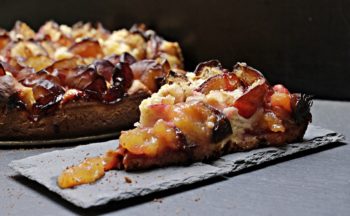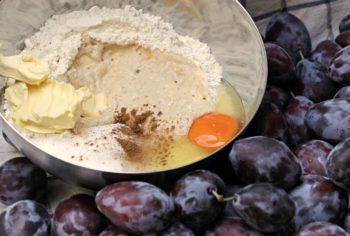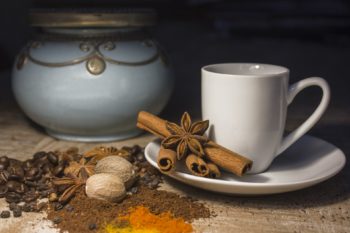Simple and delicious Polish fruit cake Posted by Kasia on Aug 28, 2020 in Culture
There is nothing more delicious than a cake with fresh fruit in the summer and fall months!
Nothing better than slicing into this fresh, filled with seasonal ingredients cake! A summer cake that I remember from my childhood (dzieciństwo) with much delight is a simple yellow cake baked in a large, rectangular pan, topped with seasonal fruit, such as a blueberries (jagody), cherries (wiśnie), or plums (śliwki). I think that plums were my favorite fruit in it! Quick, easy, fluffy and juicy! Yum!
Poland’s hot summer (gorące lato) and cold winter (zimna zima) create a similar growing season to the American Midwest, and traditional Polish desserts frequently feature berries like currants (porzeczki), wild blueberries (jagody), and strawberries (truskawki) pulled from their lush forests and orchard fruits like plums (śliwki), apples (jabłka) and apricots (morele) that ripen in abundance.The recipes (przepisy) are usually really simple! Few ingredients you would usually need are vanilla, eggs, sugar and fresh butter. The fruit makes the finished product super moist, a lovely contrast with the buttery crispness of the crust.
Every day is a good day for cake! And especially for a fruit cake! Was it always like this?
Over the course of centuries, Polish cuisine and its variety of desserts have kept on changing. The alterations were linked to different trends and the influence of other countries. Baroque-era desserts were laced with anise (anyż), saffron (szafran), cardamom (kardamon), turmeric (kurkuma), vanilla (wanilia), nutmeg (gałka muszkatołowa) and cloves (goździki) instead of sugar.
The hits of those days were different cakes: sponge, French, almond, gingerbread, wheel cakes called kołacze, old-fashioned macaroons , fruit cakes and cream horns called ulipki z pianą.
Desserts as we know them replaced their predecessors in the Enlightenment era, when French cuisine reached Poland and sugar gained popularity. Around the same time, tea (herbata) and coffee (kawa) first appeared on menus.
The golden age of cafés and pastry shops began in the 20th century and the inter-war period. Coffeeshop life flourished and the artistic and intellectual elite chose them as places of meeting and debate.
Today we are witnessing a revival in Polish pastry-making. A lot of pastry shops are bringing old classics back to life…and one of them is definitely placek ze śliwkami!

Build vocabulary, practice pronunciation, and more with Transparent Language Online. Available anytime, anywhere, on any device.







Comments:
Bill James:
Your blog is fantastic! It’s great for vocabulary building, plus it has fun insights into Polish life and culture — and comments that sometimes bring back childhood memories. (James was once Dziejma.)
Just one thought: with the beautiful photo of the Polish fruit cake, why not include a recipe?
Keep up the wonderful service you provide all of us.
All the best,
Bill
Again, many thanks.